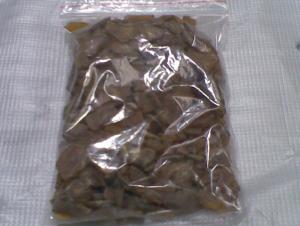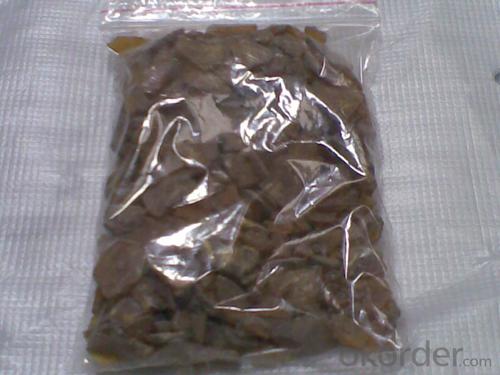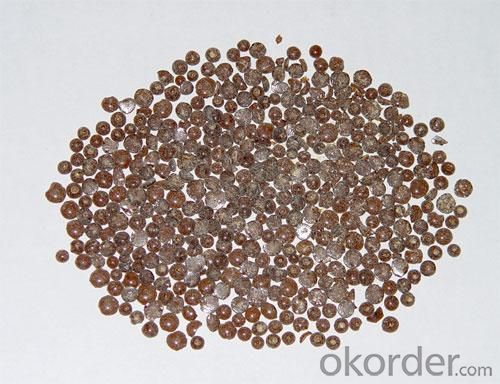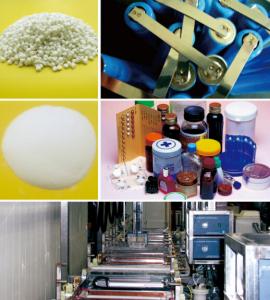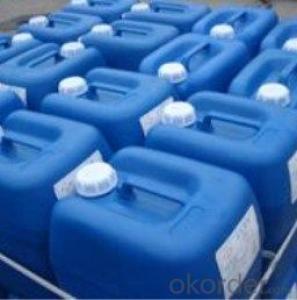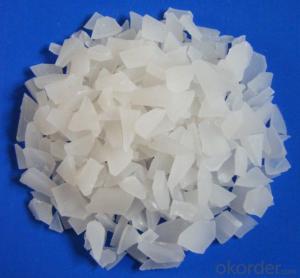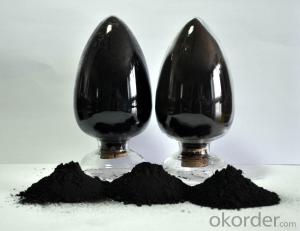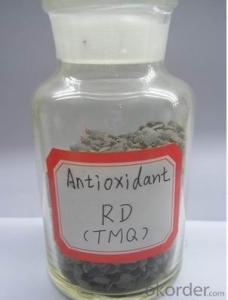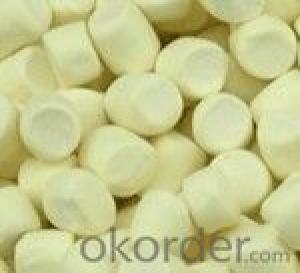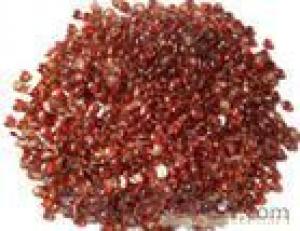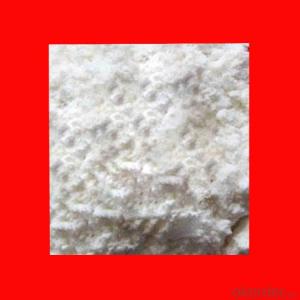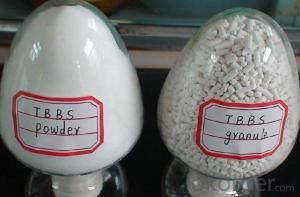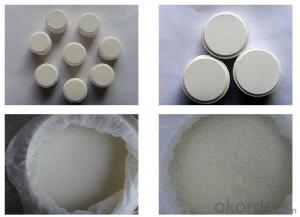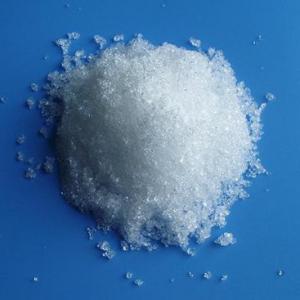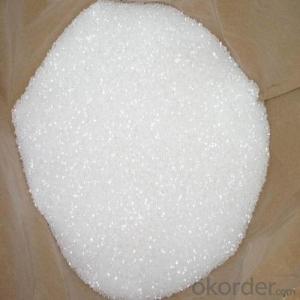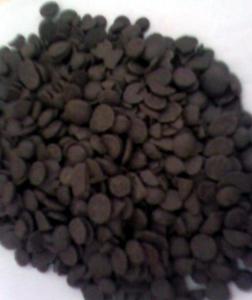Rubber Antioxidant RD (TMQ)
- Loading Port:
- China Main Port
- Payment Terms:
- TT or LC
- Min Order Qty:
- 1 Metric Ton m.t.
- Supply Capability:
- -
OKorder Service Pledge
OKorder Financial Service
You Might Also Like
1, RD (TMQ)
Chemical Name:2,2,24-Trimethy 1-1,2- Dihydroquinoline content
Molecular Weight: (173.26)n
CAS No.:26780-96-1
Executive standard: GB/T 8826-2003
Specification:
|
Item |
Index | ||
|
High Content |
High Class Product |
First Class Product | |
|
Appearance |
Amber to light brown flake or granular | ||
|
Softening Point ℃ |
90.0+10.0 |
80~100 | |
|
Heat Loss % ≤ |
0.30 |
0.30 |
0.50 |
|
Ash% ≤ |
0.20 |
0.30 |
0.50 |
|
Assay % ≥ |
77.0 |
-- |
-- |
|
Isopropyl-bis aniline % ≤ |
0.20 |
-- |
-- |
|
Issolubles in alcohol % ≤ |
0.50 |
-- |
-- |
Properties: Pale yellow to amber power or thin.Nontoxic Not soluble in water, soluble in benzene.Chloroform,acetone and carbon disulfide,Miro-soluble petroleum hydrocarbons.
Application:The product is particular excellent kinds od eneral-purpose ammonia anti-ageing agent.Ti particular suit to full-stell,semi-steel radial tire and it apply to many kinds of the tires,rubber tube,gummed tape, rubber overshoes and general industrial rubber producers and also suits to emulsion products.
Packing:25kg paper bag inner with PE bag.
Storage:The product should be stored in the fry and colling place with good ventilation. The product should be avoid hot sunshine.
- Q: What is the chemical vinyl chloride and benzene plus catalyst?
- Ethylbenzene plus hydrogen chloride
- Q: Characteristics and types of catalysts?
- Catalysts don't undergo any change. and types of catalysts - 1) Homogeneous Catalysts ( Having same phase that of reactant, product i.e. reactant and product and catalysts all are either liquid or gas or solid.). 2) Hetrogenrous Catalysts (Different Phase than that of reactant and product. 3) Autocatalysts (reaction proceed catalysed as product is formed or product catalyse the reaction.)
- Q: The "one-to-two change" of the catalyst is that the quality and chemical properties of the reactants are constant or the quality and chemical properties of the catalyst are constant?
- The morphology of the catalyst may change before and after the chemical reaction, but the quality and chemical properties of the chemical reaction do not change before and after the chemical reaction. It is noteworthy that this does not mean that the catalyst is not involved in chemical reactions. Some chemical catalysts are involved in chemical reactions, but in the form of intermediates, consume a certain amount of catalyst in a chemical reaction, but in the subsequent chemical reactions, the same quality of the catalyst will be produced. On the whole, the quality of the catalyst before and after the chemical reaction is not changed.
- Q: Also, how is the catalyst affected by heat? Please answer all of the questions not just one of the three. THANK YOU!
- It denatures the catalyst because the rise in pH or amount of H3O+ ions. Temperature will also denature the catalyst if it's out of its optimum range.
- Q: a) A catalyst such as chlorophyll must be present for some reactions to take place.b) A catalyst such as chlorophyll is not one of the products of a chemical reaction.c) A catalyst such as chlorophyll is not a substance that is used or changed in a chemical reaction.
- Perky, I doubt that it would be B because everything could be said to be the result of a chemical reaction. I think the answer is C because you could paraphrase it to say; chlorophyll is a substance that does not participate in any chemical reactions, which is of course, not true.
- Q: What are the requirements for the catalyst for the chemical industry?
- Generally find a few, according to the cost and cost of cost, choose cost-effective
- Q: Thorough explanation pls.
- A catalyst is a substance that increases the rate of a chemical reaction.
- Q: Before and after the chemical reaction, the nature of the catalyst unchanged this statement right? Why?
- Yes the the catalyst only act as a catalyst and does not participate in the chemical reactions
- Q: Chemical reaction in the presence of catalyst for the reaction are carried out a high life
- Theoretically are carried out, but some of the reaction is relatively slow, so we classified it as non-response, the catalyst is only to speed up or slow down the reaction rate of the reaction itself does not affect the reaction. I'm on high school.
- Q: Can you describe at least 4 ways a catalyst can lower the activation energy of a reaction?
- To see how a catalyst accelerates the reaction, we need to look at the potential energy diagram shown below which compares the non-catalytic and the catalytic reaction. For the non-catalytic reaction, the figure is simply the familiar way to visualize the Arrhenius equation: the reaction proceeds when A and B collide with succificient energy to overcome the activation barrier. The change in Gibbs free energy between reactants, A + B, and the product P is delta G. The catalytic reaction starts by bonding of the reactants A and B to the catalyst, in a spontaneous reaction. Hence, the formation of this complex is exothermic and the free energy is lowered. There then follows the reaction between A and B while they are bound to the catalyst. This step is associated with an activation energy; however, it is significantly lower than that for the uncatalyzed reaction. Finally, the product P seperates from the catalyst in an endothermic step. The energy diagram illustrates 4 ways the catalyst works : The catalyst offers an alternative path for the reaction that is energetically more favorable The activation energy of the catalytic reaction is significantly smaller than that of the uncatalyzed reaction; hence the rate of the catalytic reaction is much larger The overall change in free energy for the catalytic reaction equals that of the uncatalyzed reaction. Hence, the catalyst does not affect the equilibrium constant for the overall reaction. A catalyst cannot change the thermodynamics of a reaction but it can change the kinetics. The catalyst accelerates both the forward and the reverse reaction to the same extent. In other words, if a catalyst accelerates the formation of product P from A and B, it will do the same for the decomposition of P into A and B.
1. Manufacturer Overview
| Location | Shandong, China |
| Year Established | 2004 |
| Annual Output Value | Above US$ 10 Million |
| Main Markets | North America; South America; Eastern Europe; Southeast Asia |
| Company Certifications | ISO 9001:2000 |
2. Manufacturer Certificates
| a) Certification Name | |
| Range | |
| Reference | |
| Validity Period |
3. Manufacturer Capability
| a) Trade Capacity | |
| Nearest Port | Qingdao Port |
| Export Percentage | 41% - 50% |
| No.of Employees in Trade Department | Above 10 People |
| Language Spoken: | English; Chinese; |
| b) Factory Information | |
| Factory Size: | Above 13,000 square meters |
| No. of Production Lines | Above 2 |
| Contract Manufacturing | Design Service Offered; Buyer Label Offered |
| Product Price Range | High; Average |
Send your message to us
Rubber Antioxidant RD (TMQ)
- Loading Port:
- China Main Port
- Payment Terms:
- TT or LC
- Min Order Qty:
- 1 Metric Ton m.t.
- Supply Capability:
- -
OKorder Service Pledge
OKorder Financial Service
Similar products
Hot products
Hot Searches
